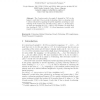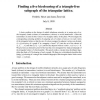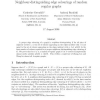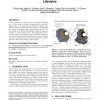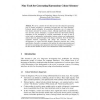IWPEC
2010
Springer
13 years 10 months ago
2010
Springer
The Grundy number of a graph G, denoted by (G), is the largest k such that G has a greedy k-colouring, that is a colouring with k colours obtained by applying the greedy algorithm ...
JUCS
2002
13 years 12 months ago
2002
: In this paper, we study the number of tilings of the hyperbolic plane that can be constructed, starting from a single pentagonal tile, the only permitted transformations on the b...
DM
2002
14 years 3 days ago
2002
A basic problem in the design of mobile telephone networks is to assign sets of radio frequency bands (colours) to transmitters (vertices) to avoid interference. Often the transmi...
COMBINATORICS
2006
14 years 10 days ago
2006
It is proved that, if G is a K4-minor-free graph with maximum degree 3, then G is totally 4-choosable; that is, if every element (vertex or edge) of G is assigned a list of 4 colo...
COMBINATORICS
2006
14 years 10 days ago
2006
A proper edge colouring of a graph is neighbour-distinguishing if for all pairs of adjacent vertices v, w the set of colours appearing on the edges incident with v is not equal to...
DM
2008
14 years 11 days ago
2008
It is proved that edges of a graph G with no component K2 can be coloured using at most 2 log2 (G) + 1 colours so that any two adjacent vertices have distinct sets of colours of t...
MM
2010
ACM
14 years 15 days ago
2010
ACM
Colour permeates our daily lives, yet we rarely take notice of it. In this work we utilise the SenseCam (a visual lifelogging tool), to investigte the predominant colours in one m...
SIROCCO
2000
14 years 1 months ago
2000
A graph with n vertices and maximum degree cannot be given weak sense of direction using less than colours. It is known that n colours are always sufficient, but it has been conje...
APCHI
2004
IEEE
14 years 4 months ago
2004
IEEE
We survey a number of tools that have been developed for generating sets of colours according to commonly accepted rules for colour harmony. Informal manual techniques for generati...
VISUALIZATION
1996
IEEE
14 years 4 months ago
1996
IEEE
In this paper we describe a technique for choosing multiple colours for use during data visualization. Our goal is a systematic method for maximizing the total number of colours a...
